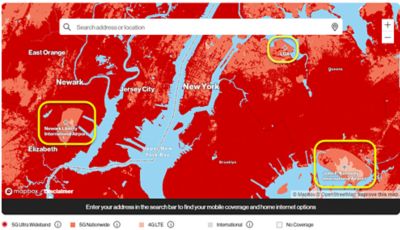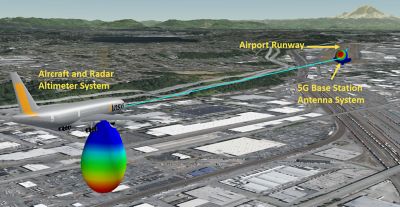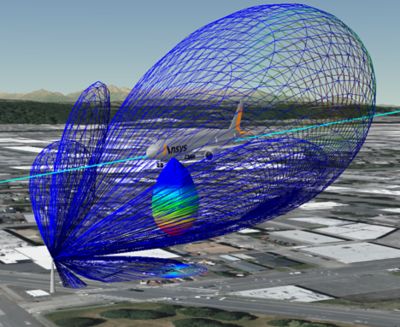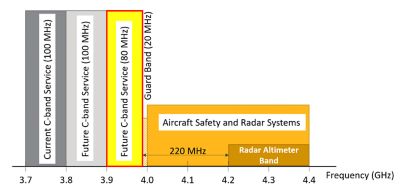-
-
Access Free Student Software
Ansys empowers the next generation of engineers
Students get free access to world-class simulation software.
-
Connect with Ansys Now!
Design your future
Connect with Ansys to explore how simulation can power your next breakthrough.
Countries & Regions
Free Trials
Products & Services
Learn
About
Back
Products & Services
Back
Learn
Ansys empowers the next generation of engineers
Students get free access to world-class simulation software.
Back
About
Design your future
Connect with Ansys to explore how simulation can power your next breakthrough.
Free Trials
ANSYS BLOG
March 10, 2022
5G and Aircraft Safety Part 3: How Simulation Can Validate Interference Scenarios
The new 5G C-band service is now up and running in the U.S., and subscribers are finally starting to see some of the promise of 5G that we’ve been hearing about. The new C-band services are primarily in spectrum allocations between 3 and 4 GHz, providing the wider channel allocation bandwidths necessary to deliver significantly higher data throughput. At the same time, signals at this frequency can travel significantly farther than with the mm-wave band. Customers of AT&T and Verizon have been reporting download speeds ranging from 400 megabits per second (Mbps) to as much as 800 Mbps, which represents a nearly 10x improvement over 4G LTE systems.
However, you can’t get this faster service at the airport — at least not yet. The U.S. Federal Aviation Administration (FAA) has worked out a six-month agreement with the telecommunications providers to keep the C-band transmitters turned off near the affected airports. During this time, the FAA continues to examine the radar altimeter systems used in commercial aircraft for certification, as well as to further study possible additional constraints needed for the nearby 5G C-band base stations.

Verizon 4G/5G coverage map around the New York City airports, dated Feb. 24, 2022. The lighter colors around the airport indicate that lower-frequency 5G service is available within the region, but not the new Ultra Wideband (C-band) service. Source: Mapbox.
This six-month hiatus currently affects about 500 towers nationwide, around 87 airports. As of February 25, an estimated 90% of commercial airline aircraft have been approved for landing under the current agreement based on their radar altimeters’ ability to deal with interference from C-Band 5G base stations outside the airport zones on the 3.7-3.98 GHz bands. At some airports, the aircraft approved for landing approach and takeoff vary by runway, creating aircraft scheduling challenges between airlines and airport management. For example, at Chicago’s Midway International Airport, only one runway is cleared for 100% of the aircraft types served by the airport, whereas the other four runways are cleared for between 81% and 95% of aircraft types.
In July, Verizon and AT&T are expected to energize the C-band service towers for enhanced 5G service closer to, and perhaps including, the airport campuses. During that time, the telecom service providers and the FAA will presumably have negotiated and settled on the acceptable parameters of operation for those new C-band 5G base stations. In addition, it is expected that the FAA will have completed testing on the radar altimeters that are currently in use throughout the aviation industry and their interactions with closer 5G towers.
Validate Interference Scenarios Through Simulation
We have to consider many variables to test and validate (and mitigate!) the potential for interference at any airport. It appears that each airport runway will need to be tested against each 5G C-band service tower that is within 2 miles of the airport approach and takeoff flight paths. Some of the key variables could be:
- Location of each C-band 5G antenna system near the airport (including situations involving multiple base stations).
- Power levels and antenna type used in the C-band 5G antenna system.
- Beam pointing capabilities of the C-band antenna system (if mu-MIMO system).
- Aircraft flight path, glide slope, and range of roll, pitch, and yaw angles that the aircraft might experience during its landing or takeoff.
- Expected aircraft flight path and parameters for “go-around” situations (generally higher altitude approach at landing).
- Type and installation location of the radar altimeter antenna system on the aircraft.
Variations in the flight path and aircraft dynamics should be considered to determine worst-case scenarios for interference situations. These could include aircraft roll during landing due to wind gusts and turbulence, which could rotate the aircraft radar altimeter antenna to stare into a nearby 5G C-band base station on the ground.
Exploring these cases through experimental flight is extremely costly and require control of the airspace and the electromagnetic spectrum around the airport during testing. Repeating these experiments for each of the variables listed above is simply untenable. But with modeling and simulation, we can explore these scenarios virtually and automatically, yielding the top scenarios that may warrant a final flight test for measurement-based validation.
With modeling and simulation, we can explore any radar altimeter, on any aircraft, at any airport runway, against any C-band 5G service towers that exist within a given radius. Given models of sufficient fidelity, this can all be done on a computer by individuals at any location without requiring flight time or impacting airport operations. Using simulation, we could:
- Explore or modify existing or planned radar altimeter systems
- Explore or modify 5G C-band base station performance parameters
- Examine cases where multiple 5G C-band base stations might exist
- Examine edge cases with respect to aircraft flight landing/takeoff dynamics (roll/pitch) which could result in antennas looking into one another’s high-gain zones
- Examine and explore reasonable limits on power, beams teering, effective isotropic radiated power (EIRP), and modifying 5G service tower keep-out zones around airports
- Provide guidance on flight planning for helicopters, private aircraft, delivery drones and more
Interference between the adjacent C-Band 5G spectrum services and RADALT systems is both predictable and solvable. Given the right tools with accurate fidelity, it should be possible for regulatory bodies, equipment and aircraft manufacturers, and telecom system providers to use simulation to examine and set coexistence guidelines that ensure aviation passenger safety under a wide variety of environment and scenario conditions. In addition, simulation can greatly reduce the final flight tests required to confirm certification of RADALT devices — enabling certification and compliance processes to keep pace with the evolution of 5G and 6G communication systems.
Simulating Interference During an Airport Approach
In my previous blog entry, I illustrated an interference analysis simulation based upon a realistic emissions model of a 5G C-band radio system, a candidate radar altimeter receiver susceptibility characteristic, and physics-based models for a C-band phased array base station and an aircraft-mounted radar altimeter antenna. In our worst-case analysis, we assumed that the 5G C-band base station was 400m from the flight line, the aircraft was at an altitude of 100m, and each antenna was looking into the other, with maximum gain pointed at one another. This may represent a possible worst-case interference situation for this combination of equipment and flight trajectory, but it doesn’t tell us about the event timeline over which serious interference might occur. In that case, we assumed our ability to guess in advance where the worst-case interference occurs for this arrangement. At a different airport and runway, we may have a different location and antenna system type for the 5G base station, and different landing dynamics may come into play during a landing or go-around flight sequence. The local scattering environment near the 5G base station may also be important if there are large buildings or line-of-sight blockages to the flight line during critical phases of landing or takeoff.
To better understand the way interference might occur during a landing, takeoff, or go-around, we need to simulate the scenario as it unfolds during the flight process. This will require simulating the interference situation during the flight sequence in an accurate virtual environment involving a particular runway of interest.
We have assembled such a simulation for a landing scenario near King County International Airport in Seattle, Washington. The figure below displays a landing scenario set up in the Ansys Systems Tool Kit (STK) software. A notional long-range, wide-body aircraft is shown with the installed antenna pattern for an installed radar altimeter system. The trajectory taken by the aircraft during landing is shown by the blue line on a south-by-southeast heading, which includes a taxi distance on the runway after landing. A 5G C-band base station antenna system is indicated directly under the flight path, with a mounting height of 9.5m, at or below roofline height of nearby buildings. STK includes local terrain in scenarios, and you can even see Mt. Rainier in the distance.

Landing approach scenario in STK for an aircraft at King County International Airport in Seattle, WA. Simulated approach includes time-indexed flight dynamics, including aircraft pitch and roll effects on radar altimeter antenna pointing.
The aircraft will pass quite close to the 5G C-band base station in this scenario as shown in the figure below, but we have the freedom to place and move our base station antennas anywhere we wish, enabling rapid re-evaluation of the scenario.

STK simulation shows landing geometry as aircraft passes close to the 5G C-band base station in the scenario. Projection of the radar altimeter gain contours can be seen on the ground beneath the aircraft.
The radios used in this simulation are identical to those defined in part 2 of our blog series, with the notable exception that the out of band saturation power level for our radar altimeter receiver is -30 dBm. It should be noted that this does not reflect the actual radar altimeter system installed on a particular aircraft, but is simply a notional system design based on the range of radar altimeter systems presented in the RTCA report to the FAA dated October 2020.
Antenna-to-Antenna Coupling Captured with Physics
An important addition to this simulation is the use of high-fidelity physics simulation in computing the antenna to antenna coupling from moment to moment during the scenario. Recall that each antenna pattern has its basis in an electromagnetic simulation by Ansys HFSS and HFSS SBR+ to capture installed radar altimeter antenna effects as well as to capture an accurate radiation pattern for the 5G C-band phased array antenna.
The antennas are set into a model of the larger scattering environment that includes tower, buildings and large scattering structures around the airport, and the antenna-to-antenna coupling is sampled by HFSS SBR+. With this solution approach, potential masking and multi-path reflections by nearby buildings and structures are included in the physical path coupling from C-band 5G base station to radar altimeter antenna. S-parameter coupling data can be computed for a single frequency or a high number of frequencies sampled across any band of interest.
Interference Scenarios for the Current and Future 5G C-band Channel Implementations
The complete landing scenario is shown, as simulated, in the video below. In the inset graph, the electromagnetic interference (EMI) margin is illustrated. EMI margin represents the interfering transmitter spectral power present across the band of interest in the radar altimeter receiver front end, minus the receiver’s ability to reject that power. When the EMI margin (black curve) rises above the red line, the potential for interference exists and the receiver is either saturated (by a strong out of band signal) or de-sensitized (by a strong in-band signal). In addition, the EMI margin legend on the plot is color-coded to signify interference at any time. Green indicates an interference-free operation in the band, blue and yellow indicate EMI margins that have crossed indicator thresholds near interference conditions, and red indicates an interference event is occurring. The following simulation is conducted with a 5G C-band system operating in the current band of 3.7-3.8 GHz:
We can see strong interference occurs as the aircraft passes over the 5G C-band tower. The radar altimeter registers interference within its operational channel (centered at 4.2 GHz), and the receiver is also saturated from the strong 5G signals that are outside of the radar altimeter’s intended band of operation.
In our previous blog, I outlined the fact that there are three tranches of 5G C-band allocations that will eventually be rolled out. The first tranche, which is currently implemented by AT&T and Verizon is the 100 MHz band from 3.7 to 3.8 GHz. This tranche has the widest separation from the radar altimeter band, with 420 MHz of buffer spectrum. But what about those other two tranches for which the telecom providers have paid, and which will be used in the future to further accelerate 5G C-band service?

We can easily change the 5G C-band transmitter definition in our simulation to consider interference potential when the telecom operator uses the 80 MHz band from 3.9 to 3.98 GHz. Because it is closer to the radar altimeter band, we might expect that the potential for interference to the radar altimeter to be enhanced, and a quick re-simulation in STK reveals this to be the case:
Available spectrum is a precious resource, and spectrum crowding continues to be a challenge as we enable new communication and sensor systems. Given sufficient fidelity in the underlying models, simulation represents a cost- and time-effective way to unobtrusively test and validate potential interference scenarios for any aircraft at any runway location. Scenarios can go beyond considering just 5G towers near the airport — with tools like AGI STK and Ansys Electronics Desktop we can look at any combination of wireless systems that might exhibit interference potential. This could become important for functions like low-altitude flight planning for helicopters, urban air mobility and drone delivery systems, for example.
Visit the Ansys HFSS and avionics pages for more information.